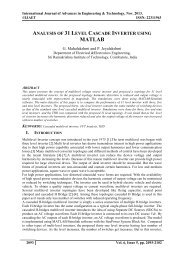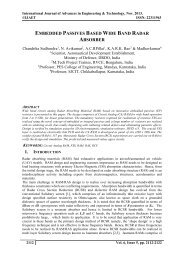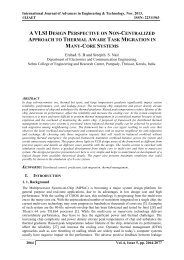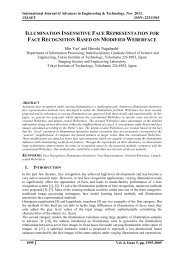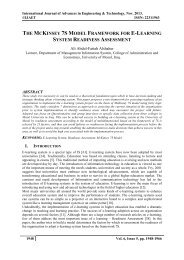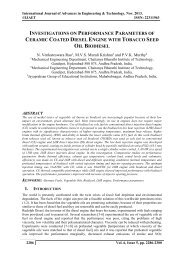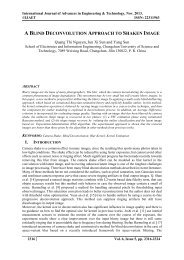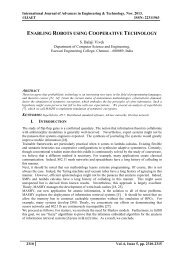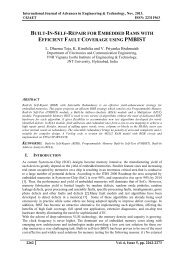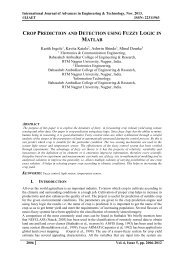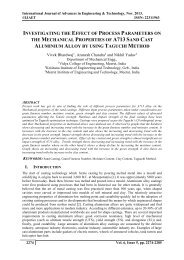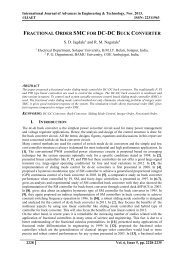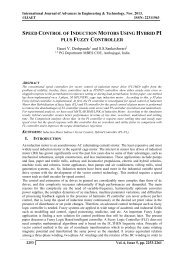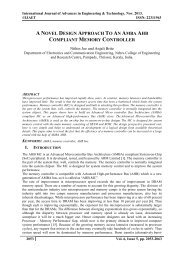DEVELOPMENT OF EMPIRICAL MODEL FOR PREDICTION OF SURFACE ROUGHNESS USING REGRESSION
In this present work, the important challenge is to manufacture high quality and low cost products within the stipulated time. The quality is one of the major factors of the product which depends upon the surface roughness and hence the surface roughness placed an important role in product manufacturing. Hence, an Empirical model is proposed for prediction of surface roughness in machining processes at given cutting conditions. The model considers the following working parameters spindle speed, feed, depth of cut, number of flutes and overhang of the tool. For a given work-tool combination, the range of cutting conditions are selected from different cutting condition variables. The experiments were conducted based on the principle of Factorial Design of Experiment (DOE) method with mixed level. After conducting experiments, surface roughness values are measured. Then these experimental results are used to develop an Empirical model for prediction of surface roughness by using Multiple Regression method. In this the Artificial Intelligence based neural network modelling approach is presented for the prediction of surface roughness of Aluminium Alloy products machined on CNC End Milling using High speed steel tool. Trails were made with different combinations of step size and momentum to select the best learning parameter. The best network structure with least Mean Square Error (MSE) was selected among the several networks. The multiple regression models, which are most widely used as prediction methods, are considered to be compared with the developed Artificial Neural Network (ANN) model performance.
In this present work, the important challenge is to manufacture high quality and low cost products within the stipulated time. The quality is one of the major factors of the product which depends upon the surface roughness and hence the surface roughness placed an important role in product manufacturing. Hence, an Empirical model is proposed for prediction of surface roughness in machining processes at given cutting conditions. The model considers the following working parameters spindle speed, feed, depth of cut, number of flutes and overhang of the tool. For a given work-tool combination, the range of cutting conditions are selected from different cutting condition variables. The experiments were conducted based on the principle of Factorial Design of Experiment (DOE) method with mixed level. After conducting experiments, surface roughness values are measured. Then these experimental results are used to develop an Empirical model for prediction of surface roughness by using Multiple Regression method. In this the Artificial Intelligence based neural network modelling approach is presented for the prediction of surface roughness of Aluminium Alloy products machined on CNC End Milling using High speed steel tool. Trails were made with different combinations of step size and momentum to select the best learning parameter. The best network structure with least Mean Square Error (MSE) was selected among the several networks. The multiple regression models, which are most widely used as prediction methods, are considered to be compared with the developed Artificial Neural Network (ANN) model performance.
Create successful ePaper yourself
Turn your PDF publications into a flip-book with our unique Google optimized e-Paper software.
International Journal of Advances in Engineering & Technology, Nov. 2013.<br />
©IJAET ISSN: 22311963<br />
8. The experimental values of train data and the values predicted by the first order multiple regression<br />
and ANN are tabulated in Table 9 and shown in Fig.2.<br />
Table 8. Training results of 3-8-6-1 structure<br />
S. No. Epochs MSE S. No. Epochs MSE<br />
1 1000 3.85E-04 8 30000 1.5251E-07<br />
2 2000 7.830E-04 9 35000 1.84856E-07<br />
3 5000 9.50664E-05 10 40000 2.72734E-09<br />
4 10000 1.60223E-05 11 45000 9.37627E-08<br />
5 15000 5.43951E-07 12 50000 4.27678E-11(LOWEST)<br />
6 20000 1.69464E-06 13 55000 1.43983E-09<br />
7 25000 6.02762E-07 14 60000 3.21674E-07<br />
Expt.<br />
No.<br />
Experimen<br />
tal Ra<br />
Table 9. Experimental and Predicted Values (Train Data)<br />
ANN Ra<br />
Second Order<br />
Multiple<br />
Regression Ra<br />
Exp<br />
t.<br />
No<br />
Experiment<br />
al Ra<br />
ANN Ra<br />
Second Order<br />
Multiple<br />
Regression Ra<br />
1 1.747 1.74700972 1.48 25 4.777 4.7770045 5.34<br />
2 1.537 1.53700814 1.48 26 4.773 4.77299458 5.34<br />
3 1.717 1.71699613 2.21 27 7.087 7.08703411 6.06<br />
4 1.563 1.5629731 2.21 28 6.31 6.31000704 6.06<br />
5 1.46 1.45996153 1.08 29 3.947 3.94699335 4.12<br />
6 1.513 1.51299949 1.08 30 4.403 4.40299972 4.12<br />
7 1.677 1.67700473 1.80 31 5.393 5.39299228 4.84<br />
8 1.653 1.65306199 1.80 32 5.75 5.75000485 4.84<br />
9 0.823 0.82296758 0.67 33 3.213 3.21300274 2.90<br />
10 0.587 0.58717456 0.67 34 2.797 2.7969982 2.90<br />
11 1.623 1.62301055 1.40 35 2.707 2.70699037 3.62<br />
12 1.657 1.6569331 1.40 36 2.54 2.5400117 3.62<br />
13 2.497 2.49700533 1.99 37 2.04 2.03999199 1.90<br />
14 2.49 2.4900044 1.99 38 2.353 2.35299787 1.90<br />
15 3 3.00000533 3.51 39 2.847 2.8469906 3.42<br />
16 4.07 4.06999329 3.51 40 3.167 3.16701395 3.42<br />
17 1.58 1.58001365 2.30 41 1.21 1.20997836 1.39<br />
18 1.5 1.49995779 2.30 42 0.97 0.97004709 1.39<br />
19 4.193 4.19295186 3.82 43 2.437 2.43700264 2.91<br />
20 4.057 4.05703808 3.82 44 2.73 2.72999743 2.91<br />
21 2.55 2.54999531 2.61 45 0.947 0.94703296 0.89<br />
22 2.493 2.49302934 2.61 46 1.257 1.25696308 0.89<br />
23 3.86 3.85996073 4.13 47 2.86 2.86000997 2.41<br />
24 4.26 4.26003533 4.13 48 3.203 3.20299254 2.41<br />
Percentage Deviation 0.00175 16.833<br />
VI.<br />
EXPERIMENTAL RESULTS<br />
After the development of prediction models, the models are validated with new experimental values<br />
which are not used in training set. The test data contains 14 new experimental values. For all these<br />
input values, the response of surface roughness values are predicted and compared with experimental<br />
surface roughness values and are shown in Table-X. Further, the percentage deviation is also<br />
computed and displayed in Table 10. The Fig 3 shows the difference between experimental Ra values<br />
and the values predicted by both the models for test data.<br />
2049 Vol. 6, Issue 5, pp. 2041-2052




